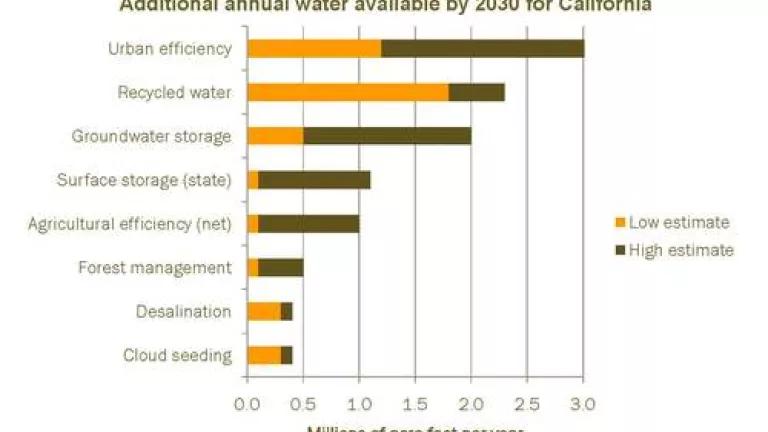
Where men build on false grounds, the more they build, the greater is the ruin. -Hobbes, Leviathan
The Bay Delta Conservation Plan (BDCP) has received much attention lately. This is a good thing. We need a comprehensive, long-term solution to the not-so-slow-motion demise of the Bay-Delta estuary, and, for all the faults of the current process, NRDC has long supported efforts to develop a credible, scientifically-based plan to restore the Delta and has worked hard to steer the BDCP in that direction. But, as my colleague Zeke Grader recently explained, the straw Bay-Delta plan released last week by the State falls far short of the goals of restoring the imperiled Bay-Delta ecosystem and providing for a sustainable future water supply. Why is it so hard to define a recipe for success in the Bay Delta?
The basics are not complicated.
1. Add Water. Less than two months ago, the State of California itself, in the form of its expert agency on water resources, described the flows that are needed to restore the Bay-Delta ecosystem and the salmon, sturgeon, steelhead and many other species it sustains. The State Water Board established those flows after hearing from a wide range of independent academics, scientific experts, and stakeholders who care about and depend on the Bay-Delta. The State Water Board’s report reflects the current state of the science and is the starting point for any credible restoration plan.
2. Create Habitat. The Bay-Delta has lost a great deal of its functioning aquatic habitat over the last 100 years of dam-building, levee creation, and land use development. We need to restore a good portion of that habitat, especially the parts that are critical for ecosystem function, like rich tidal and floodplain habitat where nutrients grow and young fish thrive. Improving upon and expanding the healthier areas of the estuary, like Yolo Basin, Suisun Marsh and Cache Slough, are the logical places to start.
3. Define Recovery Objectives. Once habitat is restored, it may be possible to modify flows and still have healthy fisheries. But to figure that out, we need to define what we mean by healthy fisheries. Even though the environmentalists participating in BDCP have been calling for this step for years, the process has yet to develop these objectives. It shouldn’t be that difficult - Congress and the State Legislature have already done some of the work, saying that salmon populations must be doubled from the levels seen during 1967-1991. What the law requires is always a good place to start.
4. Invest in Alternative Water Supplies. The State’s Department of Water Resources released a plan last year showing the untapped potential in California for vastly expanding our water supplies by investing in common-sense tools like using less water for the same job (improved urban and agricultural efficiency), using the same drop of water multiple times (more water recycling), and replenishing our depleted aquifers in wet years to store water for use in drought years (better groundwater storage and management). According to the State’s report, the first two of these measures alone can provide more water than has ever been exported out of the Bay-Delta ecosystem.
5. Let Others Test Your Product. Independent peer review is a fundamental tenet of the scientific process. Letting independent experts review and critique any BDCP effects analysis would help ensure objectivity, integrity, and the creative input of many different minds into an analysis that might otherwise be viewed as biased toward those footing the bills (primarily water exporters). BDCP should commit to obtaining independent peer review of its effects analysis by a range of scientific experts with knowledge and experience in the Bay-Delta system.
6. Seriously Consider Moving the Pumps. The giant pumps for the water projects are in a terrible location in the south Delta; not only for native fish – which can’t avoid getting sucked into the pumps or stranded in inhospitable habitat by the pumps’ pull on the currents – but also due to their extreme vulnerability in the case of an earthquake in the Delta and sea level rise due to climate change. New pumps and a new pipeline or canal may need to be part of the equation, especially to protect a reliable water supply from the threat of a catastrophic collapse of the Delta. But to justify the multi-billion dollar investment that such a change would entail, BDCP must analyze a wide range of canal and pipeline configurations, operations and pump sizes, and compare that investment against the cost of alternative water supplies and solutions. I wouldn’t buy the biggest kitchen sink on the market just because it gives me “maximum flexibility” to someday convert my home into a restaurant. There are tradeoffs associated with such a decision, including the price of the sink, installation costs, operating costs, and opportunity costs. Without analyzing the costs and benefits associated with those tradeoffs – which BDCP has still not done – forward progress is unlikely.
7. Address Delta Concerns. For BDCP to succeed, the process must be open to Delta interests, and must address local concerns like on-the-ground impacts of a new water facility, water quality, and long-term concerns regarding flood management. It’s just a bad idea to have a party in your neighbor’s backyard and not invite them.
These key ingredients are largely missing from the State’s recent straw BDCP plan. Why is that? Transitions are always painful, and the transition from a water-profligate, dam-building, fish-destroying era to an environmentally sustainable, efficient, regionally-based approach is no exception. But not planning for the future is even worse. I know – I’m from Detroit, where we came a tad late to the world of 21st century transportation and are paying a dreadful price for that failure today.
This Administration has a few more months to fix the flaws in its recent proposal and get the BDCP on track to develop a credible plan. Let’s hope they don’t waste the opportunity.
